ERIE, Colo. — The center of Colorado’s next fight over fracking is here, on Interstate-25 just north of Denver. Hydraulic fracturing, as it is properly known, has unlocked an energy boom and turned the U.S. into the world’s top oil and gas producer.
Erie’s residents acknowledge the boom’s benefits: more business, higher property values, lower energy costs, more money for schools. But many are also troubled by how the energy industry has approached their concerns about the controversial drilling method. Republican and Democratic residents alike say the industry isn’t transparent and companies drill too close to homes.
They also are grappling with the effects of economic development:
• New houses starting in the $300,000s are scooped up overnight, which means locals are being priced out of the town.
• Fracking brings in money but the wells are sometimes only a couple hundred yards from a house or playground.
• Gravel roads have been paved into urban thoroughfares, but now there are traffic jams.
The fight has grown so bitter that Erie residents don’t tell neighbors if their spouse works for the oil industry. Many won’t discuss the issue with reporters, at least not on the record.
“I just kind of try to stay low here,” says Elle Cabbage, the executive director of the Erie Chamber of Commerce. She won’t comment for the record, noting the town is “very divided.”
As Erie’s borders grew, so did its conflicts. The same goes for nearby Longmont, Greeley, Windsor and Loveland.
Many in Colorado say local governments, instead of the state, should have a right to regulate or ban fracking. Some, such as Boulder and Longmont, have voted to do so.
“I can understand companies wanting to continue it and I can even understand people arguing that fracking is beneficial,” says Tom O’Connor, a 49-year-old restaurant manager from Longmont. “What I don’t understand is how they can come down from the top and decide that the local community cannot ban fracking. That’s ridiculous to me. That’s insane.”
The state, including Democratic Gov. John Hickenlooper, says local restrictions may block access to mineral rights. The industry argues that it’s difficult to work when there is a patchwork of regulations.
Local freezes and bans have hit mineral owners. Bill Peltier, a 49-year-old auto warehouse owner in Denver who owns mineral rights, says Boulder’s fracking moratorium prevents him from developing oil and gas, although he notes that tumbling energy prices have made such ventures less alluring.
“I went to school in Boulder, we’re 49. I’m not from like Fox News. I just believe in personal freedom and personal property rights, the kind the country was founded on,” he says. “I just sit there and go, ‘Gosh this is kind of crazy.’ And now we kind of missed the big boom in developing that shale.”
The conflicts aren’t just in Colorado, as fracking creates boom towns in North Dakota, West Virginia, Pennsylvania and elsewhere. It has pitted the the possibility of new wealth for states and their residents against fears about air and water pollution, increased traffic congestion and property rights. Among the anti-frackers, there is a division among those who believe fracking should be stopped until there is enough reliable data on the relatively new technology to show it’s environmentally safe, those who say none of the oil and gas can come out of the ground for fear of exacerbating climate change and those who just don’t want wells in their backyards.
In New York, communities in the state’s Southern Tier, atop the Marcellus shale and next to fracking-rich Pennsylvania, are considering the extreme step of seceding from the state following Democratic Gov. Andrew Cuomo’s administration’s move to ban fracking. In Maryland, state lawmakers passed legislation to block fracking for 2.5 years. Last year, California counties San Benito, Santa Cruz and Mendocino voted to keep the drilling method away. In November, residents of Denton, Texas, the state at the heart of America’s oil and gas boom, passed a ballot measure banning it. Campaigners in Oklahoma are looking to handcuff would-be frackers after scientists there linked it to hundreds of small earthquakes.
All those fights have their roots in Colorado, where activists have scored a string of successes by getting towns to ban or limit fracking within their boundaries. The state’s Supreme Court is weighing whether local governments have that power.
“[The industry] is operating in other states, and they see Colorado as a test case,” says Jon Haubert, spokesman with industry-backed Coloradans for Responsible Energy Development. “You see that happen whether it’s logging or mining, you see these kind of battles royal play out quite a bit.”
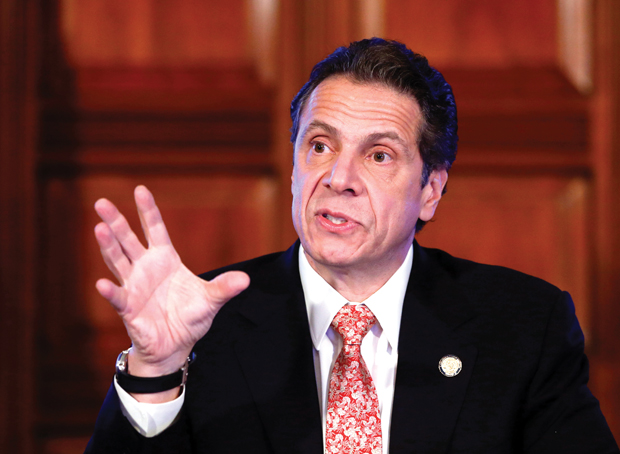
Heading for the 2016 ballot?
Colorado’s battle royal was put on hold last year for the midterm elections but is expected to heat up in advance of the 2016 race.
Colorado Democrats Hickenlooper and Rep. Jared Polis agreed in August to shelve a pair of anti-fracking ballot initiatives Polis was financing. They were causing campaign problems for pro-industry Hickenlooper and then-Sen. Mark Udall, another Democrat, both of whom were running for re-election.
One result from the compromise was a 21-member Oil and Gas Task Force, in which few people on either side put much faith. When the panel’s recommendations failed to include the two measures sought by activists — tripling or quadrupling the allowed distance between drilling and schools, homes, hospitals and other buildings, and giving local governments more control over fracking — anti-fracking activists quickly signaled they would work to put the measures on the 2016 ballot.
“It wasn’t any surprise given the task force failed,” Polis told the Washington Examiner. “Because the commission failed, really, it’s all fair game. And there’s a bunch of radical proposals out there. [A ballot push is] certainly what a lot of the groups are talking about.”
The energy industry, through several front groups, has poured money into radio and TV advertisements. It spent $11.8 million on state elections, excluding House and Senate races, in the 2014 cycle, compared with about $800,000 in the previous two elections, according to Colorado Ethics Watch. Of that, $11.6 million went to an industry-backed ballot measure to undercut anti-fracking proposals. Moving wells farther away from houses would slash the number of drilling locations up to 50 percent and cost the state economy billions of dollars a year, according to a University of Colorado-Boulder study.
“No one can read the tea leaves and see what will happen in 2016, much like what happened in 2014. Who knows what something could or could not look like?” says Robin Olsen, a spokeswoman with Anadarko Petroleum Corp., one of the biggest players in the state. Anadarko and Noble Energy are the money behind Coloradans for Responsible Energy Development, an educational group. More than a dozen companies, including Anadarko, fund Protect Colorado, an advocacy organization that pushed the pro-fracking ballot measure.
A ballot question in 2016 is inevitable, many people say, because the Colorado legislature needs a two-thirds majority to pass the task force recommendations, and there is little chance of that. Denver, with its first GOP-held Senate in a decade, is unlikely to support measures giving local governments control and forcing wells to pull back to 1,500-2,000 feet from houses and schools, from the current 500 feet. Even the task force couldn’t get the requisite super majority to include those items, coveted by activists, as formal recommendations.
It is suspected that another ballot push has always been the anti-frackers’ plan. Industry supporters note that nine days after Hickenlooper and Polis agreed to the task force, state records show Polis contributed $770,000 to Coloradans for Safe and Clean Energy, the group he funded last year that led the ballot push. But the group spent that sum as quickly as it came in, ostensibly to pay for services rendered before aborting the ballot effort. As of Oct. 27, 2014, state records show the group has no money in the bank.
“I don’t believe I have any comment on that. I don’t think I’ve commented on that,” Polis told the Examiner when asked about the contribution. Polis told E&E News earlier this month that he wouldn’t finance any ballot efforts. But some are already underway, such as the Colorado Community Rights Network’s initiative to permit municipalities to block any industrial activity within their borders.
The industry sees the ballot push as coming from the far Left rather than the many Coloradans who, while concerned about long-term effects, have resisted calls to ban fracking.
“You can be as reasonable and sit down next to the people as you want, but unless they get 100 percent of what they want they’re going to the ballot,” says Kathleen Sgamma, vice president of government and public affairs with industry group Western Energy Alliance. “Industry compromised. We gave at that negotiation.”
But Cliff Willmeng, a board member with the Colorado Community Rights Network, said the ballot push is coming from citizens that span the political spectrum. Willmeng says his group’s effort is about giving communities a voice.
“Over years of effort, people in Colorado have found the political process to be a dead end, and we can no longer ask permission to protect our communities from the oil and gas industry,” Willmeng said in an email. “The Colorado Community Rights Amendment will give voters a decision on how much power corporations will be allowed, where that power conflicts with our community’s right to health, welfare, and basic safety.”
Those who led the push last summer are being coy, but are keeping the idea of a ballot effort alive. In a 2016 election that features a presidential contest that will bring more liberals and independents to the polls, anti-fracking measures could find more support. National groups are weighing whether to get involved. Some, such as Food & Water Watch, never left.
“I think there will be,” Bob Winkler, a volunteer with local group Weld Air and Water, says while seated at a Panera Bread in agrarian Greeley.
“It’s on the table,” Sharon Carlisle, founder of Protect Our Loveland, which narrowly failed to institute a fracking moratorium, adds with a wry smile.
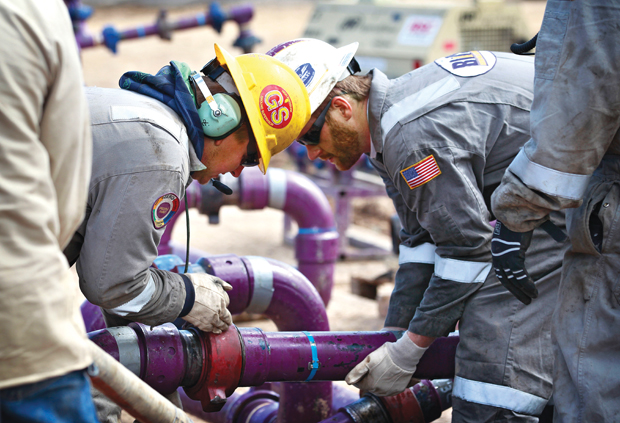
Ground zero
Erie is ground zero for the disputes over property rights and environmental protection that the rapid spread of fracking has unleashed. Debate got so heated that one person interviewed by the Examiner emailed to ensure they were removed from the story for fear of retribution. (The Examiner obliged.) Others went to pains to ensure their comments wouldn’t be cast in a confrontational light.
“You don’t tell them your husband works for an oil company. When they say, ‘Hey, what does your husband do?,’ you just smile and change the subject,” says 28-year-old Chelsie Kersey, whose husband works in the industry.
Colorado’s fracking fight is complicated by its property laws. It operates a “split estate” system, which separates property rights above ground from mineral rights below. The 600,000 residents who own mineral rights received $614 million in royalties in 2012, according to the National Association of Royalty Owners.
Landowners who allow drilling on their property receive some compensation. Yet many don’t want a rig on their lawn, nor the noise that comes with the drilling and fracking, a process that lasts at least three weeks. But if a surface owner refuses to permit fracking on his or her property, a person or company who wants to develop the minerals can go to a more willing neighbor and bore laterally underneath the property of the recalcitrant anti-fracker.
“They’re both a real property right,” says Michelle Smith, Colorado president of the National Association of Royalty Owners. “The surface owner does not have the right to deny a mineral owner access to his real property without just compensation…I just don’t know how you could ever make all the people happy.”
In Erie, oil and gas wells are among community’s houses. In Weld County, which hosts nearly half of the state’s 54,000 active wells, they appear more common than trees.
Like many other towns along I-25, which connects Denver to Fort Collins, the areas where people lived in Erie expanded into places where energy companies owned mineral rights. In the boom’s early years, companies drilled without giving much thought to residents. Shareholder responsibility took precedence.
Calgary-based Encana was the first in Erie to learn there were repercussions. In November 2014, residents opposed drilling in the company’s Pratt development, about 750 feet from homes. The company was outside the required 500 feet. But the well encountered problems and the resulting noise around Thanksgiving created a “furor,” says Encana spokesman Doug Hock.
“They’re upset and rightly so,” Hock says. “We just couldn’t figure it out. In hindsight, we were probably [at the Pratt site] too long.”
Encana moved out of the Pratt development in December. In January, when the company tried to renew the memorandum of understanding it signed with Erie in 2012, the town’s board of trustees surprised the company by saying it would vote on a fracking moratorium. Hock says the company was “very taken aback.”
The trustees eventually voted 4-3 to renegotiate the agreement, which remains in place today. But another moratorium push is expected.
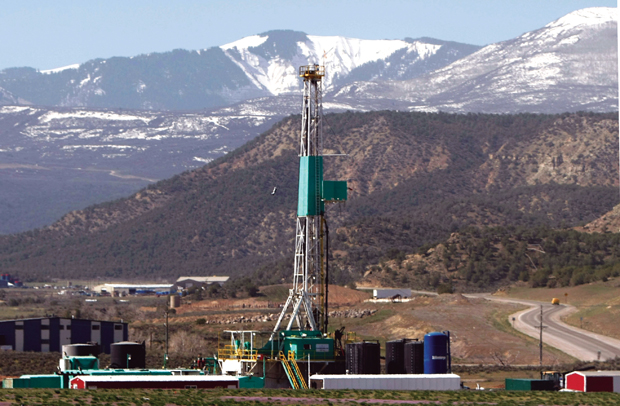
‘Erie has kind of outgrown us’
To say fracking has transformed the town is an understatement.
Drivers exiting I-25 toward Erie, which straddles Weld and Boulder counties, are greeted by large placards announcing new homes in this formerly rural town. A mile outside town, row upon row of cookie-cutter houses, some still being built, give the appearance of suburban barracks.
“They’ll sell in a night,” says Rachel Frazer, a 31-year-old hair salon owner in “Old Town,” the one-road downtown that used to be Erie. “I have people come in here and say, ‘Yup, it was up there for two hours and it sold.’ Which is funny because I feel like a lot of the people that are here can’t afford to live here anymore. Which is crazy because as of two years ago it was not like that.”
While Colorado’s oil and gas industry doesn’t account for its entire population increase, it has played a major role. At the turn of the millennium, 6,291 people lived in Erie. In 2013, the population tripled to 19,723. Median household income rose to $103,796, a 34.6 percent increase over 2000 and nearly double the national average.
“Erie only had two paved roads up until 10 years ago, and everything else was a gravel road,” says Rick Seeley, a 64-year-old Erie resident who recently sold his 1970 Volkswagen, a self-described “hippy bus” that sported a “No Fracking” sticker. “And now it’s so funny to see everyone come in referring to it as, ‘Our little town.’ And nobody ever wanted to come here. This was like the ghetto of the world. And now everybody just absolutely loves it.”
Old Town, where Frazer is dyeing Kersey’s hair, has a few restaurants, a busy post office, and Miner’s Tavern, a bar that boasts it’s been in operation since 1926. A newer shopping complex opened closer to the highway, adjacent to an opulent park that has four baseball diamonds (Encana bought the lights), skateboard park, new library and community center.
Frazer notes the influx of people who live nearer I-25 has been great for business. But she has been priced out of Erie. She says a mobile home down the street is going for $316,000.
“Erie has kind of outgrown us. I can’t afford to buy here. I can’t. We are just now looking to buy ourselves, and we can’t buy here or most of the surrounding areas. So that’s something that will take us elsewhere. Our time to buy here was probably five years ago,” she says.
Those are also the signs of a robust economy, driven largely by oil and gas.
An estimated 33,897 people worked in the industry in 2013, earning $104,626 on average, according to a recent University of Colorado-Boulder study. That’s the most who have ever worked in Colorado in the industry, and they’ve got money to spend — wages grew 4 percent, compared with 0.6 percent for other industries.
Excluding the Gulf of Mexico, Colorado is the country’s eighth-biggest oil producer and seventh-biggest natural gas producer, according to the Energy Information Administration. Natural gas production steadily climbed after 1987, though production dipped in 2013 to 1.6 million cubic feet. Oil output was cut in half between 1988-2001, producing 16.5 million barrels, but has risen since, with production spiking 161.6 percent between 2010-2014 and hitting 85.7 million barrels.
The industry supplied more than $1.1 billion in state tax revenue in 2013, according to the UC-Boulder study, a windfall for schools and public services. Oil and gas companies occupy one-third of downtown Denver’s office space, according to early results from an industry-supported study.
Towns have expanded with the economy. Olsen, of Anadarko, says the urban corridor along I-25 “has grown dramatically, as has oil and gas development.”
That’s why a 1,500-foot setback that activists have sought would “nearly wipe out the Wattenberg,” Olsen says, referring to the shale region’s name. Other predictions are less dire. The UC-Boulder study said a 2,000-foot setback, another option activists pushed, would slash the number of drilling locations by 25-50 percent, costing the state economy between $3.2 billion and $6.4 billion annually through 2040.
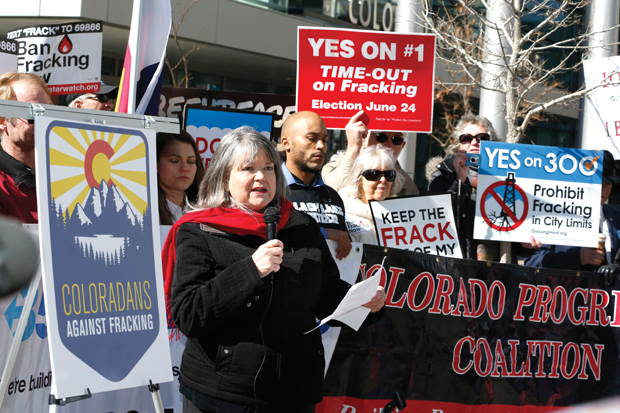
The fight over the environment
Herschel Phelps, an 84-year-old conservative and Greeley resident, says the boom enabled him to sell three rental properties he owned for what he considered fair market value. But oil and gas wells are close to houses in Greeley because they were drilled before the state implemented its 500-foot setback. An oil well sits yards away from the dog park where Phelps is lounging.
“I think that so many people are short-sighted. And of course the short-sighted view is, jobs, and money, and improved economy. And you can’t argue against that. But in the long run, I think fracking may turn out to be a very bad thing for our environment,” Phelps says.
Americans as a whole are split over fracking, with 40 percent supporting it and 40 percent opposed, according to a March Gallup poll. In Colorado, many are concerned about environmental damage and think the industry is hiding something, a sentiment the Gallup poll found nationwide.
The industry has rejected claims by environmental and public health groups that fracking pollutes groundwater. Early in the fracking renaissance there were documented cases of fracking wastewater spilling and polluting surface water, but the industry has largely amended those practices. It remains steadfast, however, that polluting groundwater is unrealistic. That troubles some people.
“The technology is amazing. But there’s also not much of humility about all the things that could go wrong,” says Sara Barwinski, a Greeley resident and member of Hickenlooper’s task force. She says a pressure release valve on a well pad abutting the high school near her home malfunctioned in 2013 to the point that “you could feel the heat.”
The blowback from the industry’s previous bluster necessitated a “radical culture change,” says Tisha Schuller, president of the Colorado Oil and Gas Association. Companies now engage communities before and during drilling.
“I really believe the industry felt several years ago, ‘We have the facts, we’re producing, we’re good.’ I think they had a very eye-opening realization that that isn’t good enough,” says Smith, of the National Association of Royalty Owners.
Anadarko has a team of community liaisons and makes employees available for town hall meetings. Whiting Petroleum, another company operating in the area, has an “ambassador” program in which employees not involved in drilling — accountants, for example — learn about fracking so they can talk about it. Encana has spent about $3.3 million in Weld County since 2007 on philanthropic endeavors, such as buying solar panels to power the Erie Community Center.
“The idea that we would ascribe a zero risk tolerance to energy development and yet we’re willing to take on the risk of filling up our car tank even though we know there’s volatiles coming off of that, the fact we’re willing to drive, use all these petroleum products — that’s a more interesting conversation,” Schuller said. “I think we usually get to the point where we have to have some tolerance for risk. This isn’t a matter of there’s zero chance. It’s just that most communities want to hear there’s zero chance.”
Spills still happen, but they’re minimal. Last year, 0.003 percent of produced oil and 0.006 percent of waste water spilled, according to the Colorado Oil and Gas Conservation Commission, the state regulator.
Air emissions are another concern. Wells produce volatile organic compounds that, when mixed with sunlight, create smog. The pollutant is subject to federal regulations, but fracking’s proliferation has put more of it in the air. People here remark that smog makes the Front Range, the mountain cluster that rings the Denver area, less visible now. Climate scientists worry that leakage of methane — a potent, short-lived heat-trapping gas — could erase the benefits of using natural gas over coal in electricity generation.
Some studies have said emissions from fracking sites could endanger health, but they have come with controversy. An oft-cited 2012 University of Colorado School of Public Health study found high concentrations of ethylbenzene, toluene, xylene and benzene, a known carcinogen, after three years of monitoring fracking sites. The Colorado Department of Public Health and Environment threw cold water on the study, saying its findings could mislead the public.
Assessing fracking’s impact on health is difficult because the advancements in technology, such as fluid compositions used to loosen tight-rock formations, are relatively new and are considered proprietary knowledge. So too is the expansion of the practice, which didn’t begin in earnest until 2009. The New York State Department of Health recommended extending the state’s fracking ban indefinitely to study the health effects.
Easing the conflicts
How fracking affects a community goes beyond where wells are placed and the unanswered questions on public health. Truck traffic has increased road dust, transportation emissions and safety concerns. Fracking might cause seismic shakes. The Oklahoma Geological Survey said last week it is “very likely” that the 585 earthquakes the Sooner State experienced last year were triggered by fracking. Colorado State University is exploring the issue, too.
Questions remain because “data collection has not kept pace with the boom in extraction,” said a March Brookings Institution study by a pair of University of Michigan professors who explored the economic benefits of fracking. “Even in locations where baseline and post-fracking water quality have been measured, it remains difficult to hold individual producers liable” because fracking occurs deep underground and because “monitoring every individual well is costly.”
The Environmental Protection Agency has faced access issues for years for a study on how fracking affects drinking water, as Inside Climate News reported in March that oil and gas companies refused to hand the agency baseline water samples.
Still, some companies are going beyond Colorado’s requirements and are trying to limit conflicts with communities.
Whiting staked out 133,000 acres far from towns for its gas-processing plant and drilling operations about 30 miles west of the Nebraska border. It takes baseline groundwater samples before and after drilling and submits the results to the Colorado Oil and Gas Conservation Commission. The company spent $30 million on 17 miles of power lines to supply its facility and $5 million to pave the road leading in and out, and will install underground pipes to transport wastewater to reduce dust from truck traffic. Whiting also will install seismic activity sensors to monitor whether its wastewater injections cause tremors.
But many see a dichotomy between big companies and smaller firms.
The small, independent drillers that have sparked the drilling boom can’t afford those types of improvements. They’re less concerned about public relations, as they need to make money to take on the significant debt needed for capital equipment. Falling prices — natural gas is at lows not seen since 2012 and the oil price has halved since June — has made the need for profits urgent. Whether companies that go belly-up will fix old wells or simply leave that task to local governments and the state is a major concern.
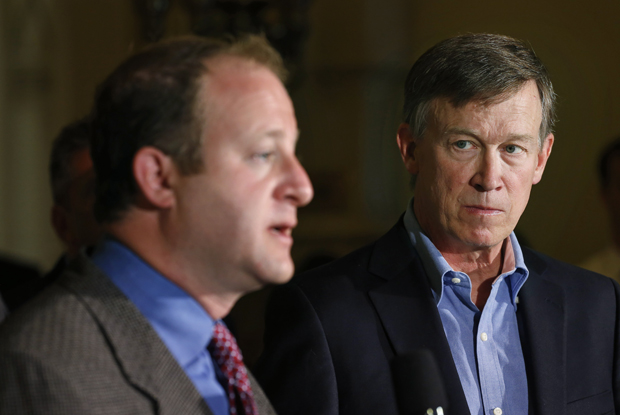
Wine-and-cheese activism
“I just want my life to go back to the way it was seven months ago,” Shawndra Barry, the leader of Windsor Neighbors for Responsible Drilling, tells seven people at Don Thompson’s home. The neighborhood, stocked with million-dollar homes and Republican votes, has been fighting a proposed multi-well drilling site adjacent to its community 38 miles north of Erie.
At an earlier meeting at a local Starbucks, with three-ring binders splayed out on a table, Barry speaks casually of getting together with friends to map out a strategy for thwarting the Windsor site. She hardly gives it a second thought that her squad of suburban mothers’ social lives now revolve around fracking. She just wants to be a normal dentist again.
The community isn’t the most sympathetic lot. It received national attention for its sleek video documenting its concerns regarding Great Western’s proposed well pad. It has four lawyers on retainer. They’re debating logistics for a long-planned neighborhood wine and cheese event to discuss their efforts to convince the small driller to move. Barry says the firm could frack from another plot, but a nearby surface owner is offering a better deal.
Thompson suggests the wine and cheese event could be a “celebratory” affair because Barry, the community’s lead organizer, has good news.
“It looks like we are going to have success, 100 percent success,” she tells the group, announcing the driller is moving its proposed site to another location. The update is met with cheers and a bit of bewilderment.
Barry says comprehensive master planning between communities and companies can mitigate the sorts of conflicts Windsor faces. The industry is hesitant, saying plans change. Fracking opponents say some local governments are too beholden to industry for something like “master planning,” even with citizens involved, to matter. Regardless, the task force’s recommendations moved Colorado toward greater government involvement and transparency from companies.
But if there’s anything Barry, a lifelong Republican who is concerned about fracking’s long-term effects on health and the environment, has learned during her fight, it’s that results require persistence. Less financially well-off people or communities may find it harder, she notes.
No doubt Barry is an anomaly. Even Hickenlooper recognizes that, as Barry informs the group that the governor has asked her to his office for a meeting.
In a state where another political fight looms, Barry is aware that her town’s story, and her just-announced success, might be used as a political ploy in the long-running Colorado fracking battle.
“I think he could also turn it into, ‘Look how great we’ve done,'” she says.
• This article has been updated.

